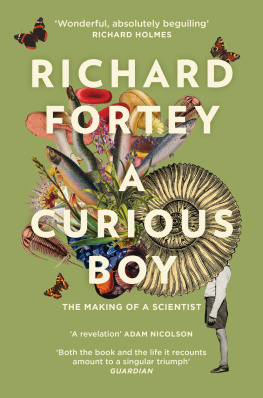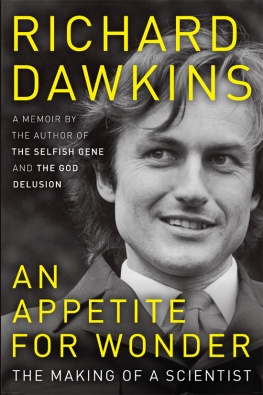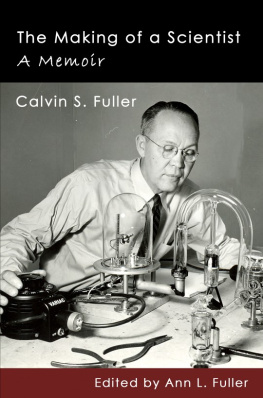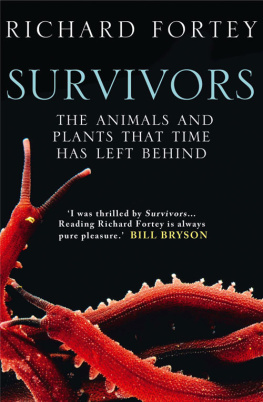Contents
Contents
Guide
A CURIOUS BOY
The Making of a Scientist
Richard Fortey

Richard Fortey spent his working life in palaeontology at the Natural History Museum, specialising in trilobites and becoming a world expert. He was elected President of the Geological Society of London for its bicentennial year of 2007 and is a Fellow of the Royal Society and of the Royal Society of Literature. He has received the Frink Medal, the Michael Faraday Prize and the Lewis Thomas Prize for science writing, as well as the silver medal of the Zoological Society for science communication. He is the writer of eight previous science and nature books, including two Sunday Times bestsellers, all of which are still in print. He has presented many television programmes across the BBC and other channels.
The Hidden Landscape: A Journey into the Geological Past
Life: An Unauthorised Biography. A Natural History of the First Four Billion Years of Life on Earth
Trilobite! Eyewitness to Evolution
Fossils: The Key to the Past
The Earth: An Intimate History
Dry Store Room No. 1: The Secret Life of the Natural History Museum
Survivors: The Animals and Plants that Time Has Left Behind
The Wood for the Trees: The Long View of Nature from a Small Wood
The definitive brown trout curated by J. Cooper & Sons. |
A predated song thrush egg picked up from my wood. |
A funnel and a few reagent bottles all that survives from my chemical boyhood. |
My first fossil, the Jurassic ammonite Parkinsonia. |
Fossils of sea urchins were common in the chalk at the edge of the Berkshire Downs. |
My old woven basket, used for collecting fungi. |
My basket, fully laden. |
A sketch of Forge Cottage, Ham, Wiltshire, made by a school friend in the early sixties. |
Fifty years of continuous botanical use. A page from my Collins Pocket Guide to Wild Flowers, with two sightings of grass of Parnassus duly recorded. |
The large Devonian trilobite Drotops from Morocco. |
In Spitsbergen. |
My drawings of the special graptolite from the Ordovician rocks of Spitsbergen from my first solo scientific paper. |
The Arctic privy. |
With Lehi Hintze in Nevada in 1972. |
William Collins
An imprint of HarperCollinsPublishers
1 London Bridge Street
London SE1 9GF
WilliamCollinsBooks.com
HarperCollinsPublishers
1st Floor, Watermarque Building, Ringsend Road
Dublin 4, Ireland
This eBook first published in Great Britain by William Collins in 2021
Copyright Richard Fortey 2021
Richard Fortey asserts the moral right to be identified as the author of this work
Cover design: gray318
A catalogue record for this book is available from the British Library
All rights reserved under International and Pan-American Copyright Conventions. By payment of the required fees, you have been granted the non-exclusive, non-transferable right to access and read the text of this e-book on-screen. No part of this text may be reproduced, transmitted, down-loaded, decompiled, reverse engineered, or stored in or introduced into any information storage and retrieval system, in any form or by any means, whether electronic or mechanical, now known or hereinafter invented, without the express written permission of HarperCollins
Source ISBN: 9780008323967
Ebook Edition January 2021 ISBN: 9780008323981
Version: 2021-10-20

Australia
HarperCollins Publishers Australia Pty. Ltd.
Level 13, 201 Elizabeth Street
Sydney, NSW 2000, Australia
www.harpercollins.com.au
Canada
HarperCollins Canada
Bay Adelaide Centre, East Tower
22 Adelaide Street West, 41st Floor
Toronto, Ontario M5H 4E3, Canada
www.harpercollins.ca
India
HarperCollins India
A 75, Sector 57
Noida, Uttar Pradesh 201 301, India
www.harpercollins.co.in
New Zealand
HarperCollins Publishers New Zealand
Unit D1, 63 Apollo Drive
Rosedale 0632
Auckland, New Zealand
www.harpercollins.co.nz
United Kingdom
HarperCollins Publishers Ltd.
1 London Bridge Street
London SE1 9GF, UK
www.harpercollins.co.uk
United States
HarperCollins Publishers Inc.
195 Broadway
New York, NY 10007
www.harpercollins.com
O n the wall of my study a trout in a glass case is facing upstream. Its mouth is slightly agape as it gulps the clear, pure water of the chalk river in which it lived. The fish is not swimming; rather, it is perfectly maintaining its position in a busy current. In life, its fins and tail swished gently to keep it exactly where it wanted to remain, alert for the small prey that nourished it to such generous proportions. Its skin glistens, not in the blatant fashion of the crudely stuffed fishes that decorate some waterside pubs along the River Thames, but sleek and subtle, a slick and a lick of varnish, just enough to suggest the slippery sides of the living animal, but not so much as to point up its artificial afterlife. It is a brown trout, a wild fish, its upper flanks broadly dotted as if by a leisurely crayon, belly silvery white and tessellated with hundreds of fine scales. Nor does it hang all by itself. The preparator has carefully placed model riverweed beneath the fish not just plonked down, but rather drawn out as if played like hair in a current. The direction of the weed points up the rush of the water, and reinforces the convincing response of the fish to its ambient flow. This is a carefully curated specimen. The front of the glass case is gently bowed outwards and framed by a thin line of gold leaf. At the bottom of the frame also picked out in gold TROUT 4 lb 13 oz. Caught by F. A. Fortey 13 May 1947 River Gade. Not long after the Second World War, my father caught this fish from the transparent waters of a stream running through the Chiltern Hills, north-west of London. I was a one-year-old baby at the time.
The trout became an heirloom, taken for granted for half a century. It may have hung in one of my fathers two fishing-tackle shops as an encouragement more likely a challenge to aspiring anglers. The time came when I inherited it and it became part of the paraphernalia that moves with your family from house to house. On one of these changes of address the removal man was carrying the fish to the truck when he suddenly stopped in his tracks, gawped, and exclaimed: Blimey! Its a Cooper! I had no idea what a Cooper was. In your fish world, said the removal man, gravely, a Cooper is like a Stradivarius. He was something of a connoisseur. Now that it had been identified I discovered a discreet little label at the back of the case: Preserved by J. Cooper & Sons, 78, Bath Road, Hounslow. No commonplace stuffing for a Cooper & Sons fish, what you got instead was preservation. These artists preserved the consummate moments of a fishermans career. I noticed for the first time the subtleties of taxidermy that lifted this fish from the merely stuffed.












